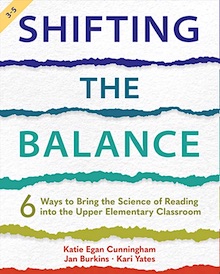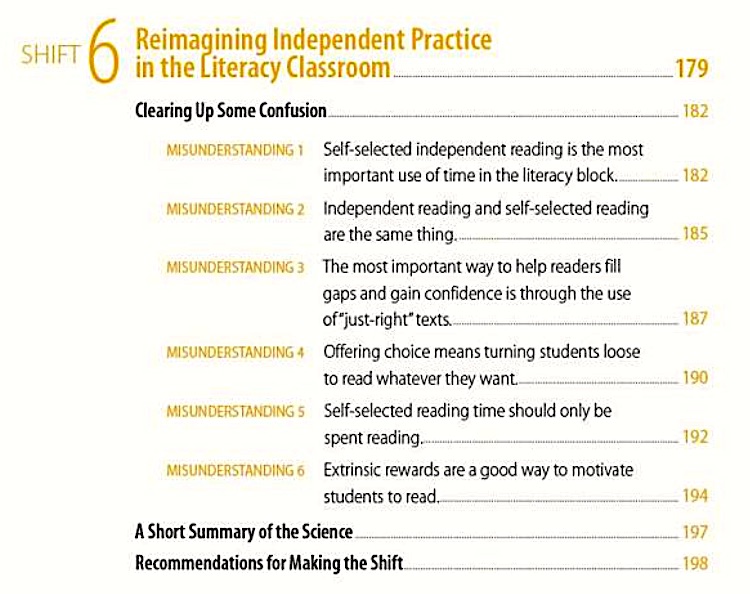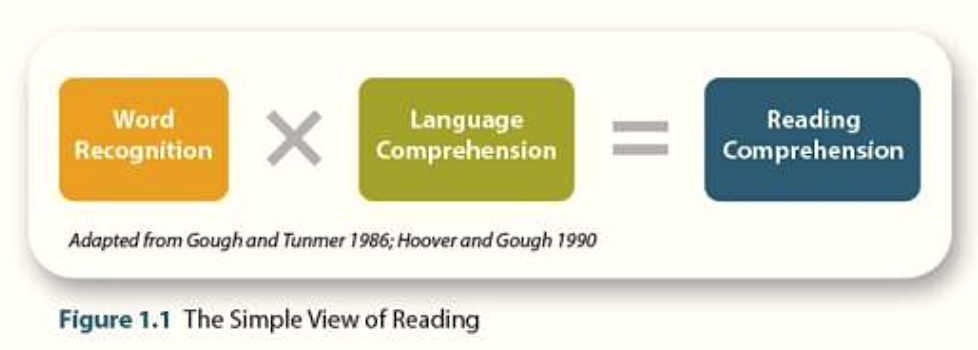Bringing the Science of Reading into Grades 3-5
Shifting The Balance, Grades 3-5: 6 Ways to Bring the Science of Reading into the Upper Elementary Classroom
By Katie Egan Cunningham, Jan Burkins, Kari Yates
(Routledge, 2023 – Learn more)
Reviewed by Kathleen Palmieri
In recent years the debate over the merits of balanced literacy versus the science of reading has intensified. The confusion and uncertainty prompted Dr. Jan Burkins and Kari Yates to dive into the research, hoping to clear up misunderstandings, find ways to pull the best pieces of practice together, and help classroom teachers “navigate competing tensions.”
The first Shifting the Balance book (Stenhouse, 2021) centered on instructional methods in the the primary grades (K-2) and became a highly rated bestseller full of “aha moments,” as one teacher reader put it.
As their research and discussions moved beyond the earliest stages of reading, Burkins and Yates were approached by literacy author Katie Egan Cunningham and the trio agreed that a second book was needed.
“While it’s true that the most heated debates about instructional methods seem to have focused on the earliest grades, there is plenty of confusion and uncertainty about practices with older students, too.” (p.4)
Working as a team, they agreed to write Shifting The Balance: 6 Ways to Bring the Science of Reading into the Upper Elementary Classroom, using this guiding question: “What does reading science really say about literacy instruction in the upper elementary classroom?” (p.4)
What’s in the new book

There is a table offering “The Shifts At A Glance” on page 7 that includes both the six shifts they identified in their earlier K-2 book and six additional shifts that emphasize practices for grades 3-5.
The grades 3-5 shifts are:
Shift 1: Reconsidering How Knowledge Impacts Comprehension (p. 11)
Shift 2: Rethinking the Role of Strategy Instruction in Learning to Comprehend (p. 41)
Shift 3: Recommitting to Vocabulary Instruction (p. 75)
Shift 4: Reclaiming Word-Reading Instruction in the Intermediate Grades (p. 113)
Shift 5: Revisiting Fluency Instruction (p. 151)
Shift 6: Reimagining Independent Practice in the Literacy Classroom (p. 179)
The structure for each chapter/shift is built around misunderstandings – current beliefs/practices that need to “shift” to help students become stronger readers.
Along with these thought-provoking areas to consider, each chapter/shift offers a glimpse inside an intermediate classroom, a common practice to reconsider, some clearing up of confusion, and “A Short Summary of the Science,” and recommendations for making the shift.
Other details about the book
The authors are balanced literacy educators and begin their book with “the end in mind.” Language comprehension is key to reading comprehension. Shift 1, “A Common Practice to Reconsider” states that “We underestimate the role of background knowledge in reading comprehension.”
In Shift 1 the authors offer this “Simple View of Reading” — “that reading comprehension is represented as the product of two essential factors – word recognition (phonological awareness, decoding, and reading words automatically) and language comprehension (the ability to understand spoken language).” (Gough and Tunmer 1986; Hoover and Gough 1990) (p. 13)
Misunderstandings are unpacked throughout the book to clarify that understanding print is truly dependent upon a child’s ability to understand the spoken language. For example, Shift 1, Misunderstanding 4, is: Building knowledge is simply a matter of exposing students to informational texts. Many times this misunderstanding results in teachers offering unrelated topics that students are “guided to read closely.” (p.25) The texts are not relatable and do not tap into background knowledge or the “inferential thinking” that is needed for true comprehension.
On page 14, Figure 1.1 (above) offers a visual of The Simple View of Reading (adapted from Gough and Tunmer 1986; Hoover and Gough 1990), emphasizing how the connection between word recognition and language comprehension results in reading comprehension. The authors state, “The Simple View of Reading is just that, a relatively simple model that explains the big picture of a very complex process.”
The Shifts in the book build upon each other, offering clarification and takeaways we can implement in the intermediate classroom.
Read a MiddleWeb article by the authors:
“Shifting the Balance with Headwork and Heartwork”
Adding depth to the reading instruction debate
Shifting The Balance, Grades 3-5 provides insight into how to help our students not only read but comprehend texts. The connection between word study and comprehension – along with relatable texts that allow students to infer and acclimate their prior knowledge with the text – cannot be stressed enough.
Throughout this book are many wonderful, research based illustrations and tables. In Shift 6 “The Simple and Scientifically Sound Shift,” the authors provide excellent recommendations. Table 6.1 (p.199) offers “High Leverage Instructional Routines For Making Independent Reading Practice Meaningful.”
At the end of each chapter, a “Questions for Reflection” page highlights six of the chapter’s implications to consider as you make the shift in rethinking routines and structures for literacy practice. The authors have also done a significant amount of research, and they append an impressive references section and include a list (p. 233) of all the “Children’s Literature Cited.”
As an intermediate educator, I found myself deeply immersed in the Shifts, as well as very reflective about my own current practices and the debate on reading instruction. I truly enjoyed reading and relating to the content in Shifting The Balance, Grades 3-5 and I highly recommend it for your professional reading. For more information, you can go to TheSixShifts.com author website.
Kathleen Palmieri is a National Board Certified Teacher and NBCT Professional Learning facilitator. She is a fifth grade educator in upstate New York who reviews and writes regularly for MiddleWeb. With a passion for literacy and learning in the classroom, she participates in various writing workshops, curriculum writing endeavors, and math presentations. As a lifelong learner, she is an avid reader and researcher of educational practices and techniques. Collaborating with colleagues and globally on X/Twitter and expanding her education adventures at www.kathleenpalmieri.com are her ongoing practices.

































